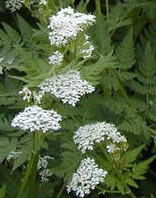 Sweet cicely is a herbaceous perennial up to three to six feet tall and wide, native to southern and central Europe but has naturalized widely in Europe and Asia. It is a member of the carrot family (Apiaceae) along with parsley, dill, fennel, and Queen Anne’s lace. The roots, stems and leaves have been used as a culinary and medicinal herb since Roman times but the plant is now a popular for its ornamental value. The leaves are fern-like and two to three times pinnately divided. Each leaflet is toothed or finely lobed and has a downy whiteness on the underside often with a white blotch on the topside. The small creamy-white flowers are carried in compound flat umbels two inches across from May to June and are composed of five to ten smaller umbels. The inner flowers are male, the outer ones bisexual. The shiny, dark brown fruits are sharply ridged and are about one inch long. Plants freely self-seed and are difficult to eradicate once established because of their very long tap root. All parts of the plant have a anise scent when crushed.
Sweet cicely is a herbaceous perennial up to three to six feet tall and wide, native to southern and central Europe but has naturalized widely in Europe and Asia. It is a member of the carrot family (Apiaceae) along with parsley, dill, fennel, and Queen Anne’s lace. The roots, stems and leaves have been used as a culinary and medicinal herb since Roman times but the plant is now a popular for its ornamental value. The leaves are fern-like and two to three times pinnately divided. Each leaflet is toothed or finely lobed and has a downy whiteness on the underside often with a white blotch on the topside. The small creamy-white flowers are carried in compound flat umbels two inches across from May to June and are composed of five to ten smaller umbels. The inner flowers are male, the outer ones bisexual. The shiny, dark brown fruits are sharply ridged and are about one inch long. Plants freely self-seed and are difficult to eradicate once established because of their very long tap root. All parts of the plant have a anise scent when crushed.
The flowers have the anise flavor characteristic of other parts of the plant. They can be used in drinks, salads, soups, fish sauces, and vegetable dishes. Whole umbels make an attractive garnish. Harvest the umbels when the flowers first open. Gently wash and dry them making sure they are free of bugs. Combine with seeds or leaves in recipes for more anise flavor.